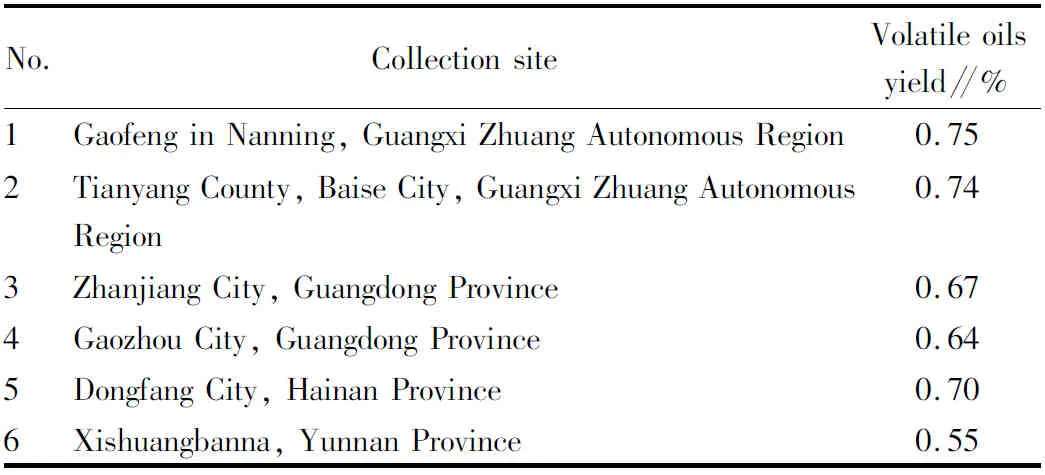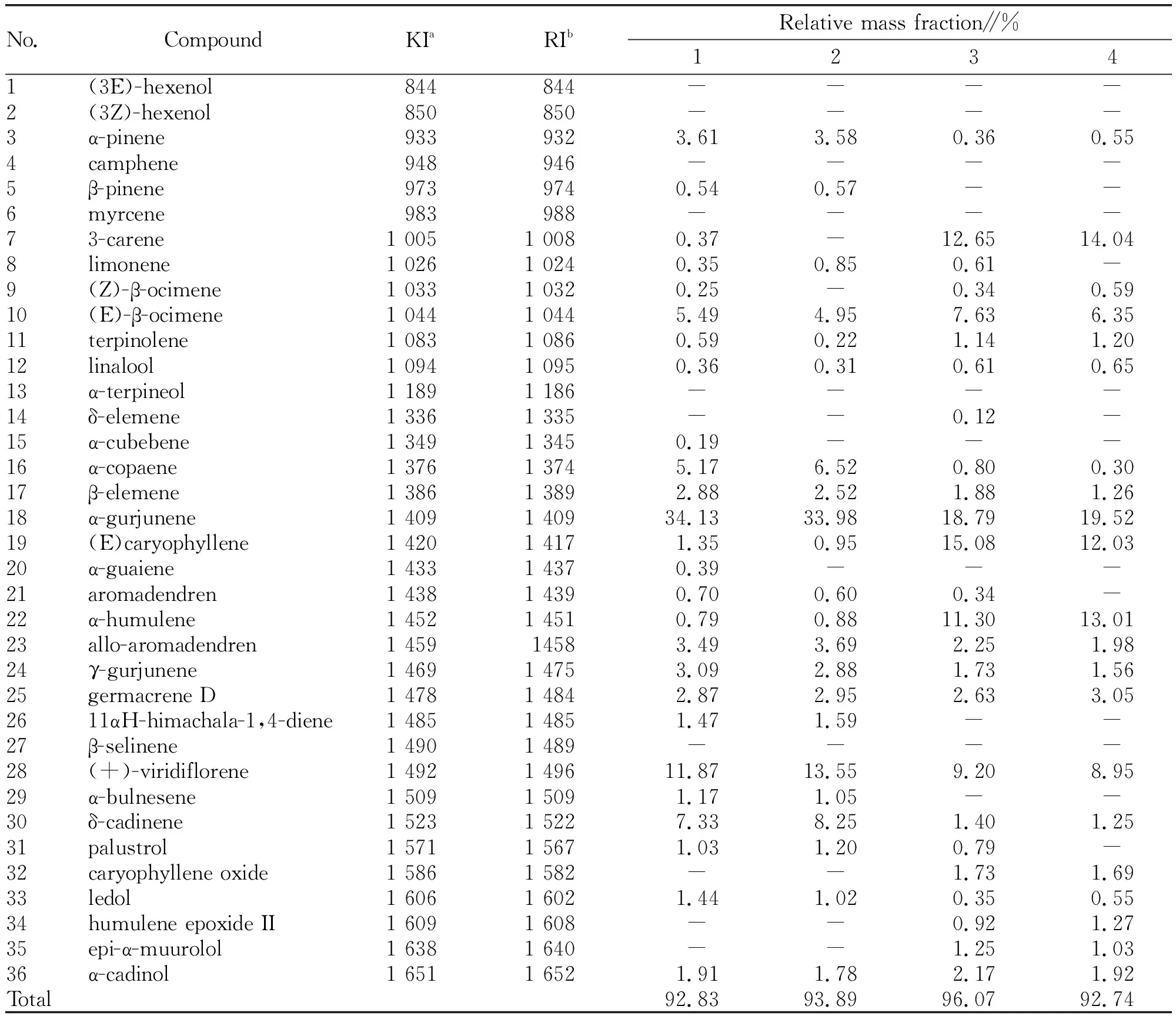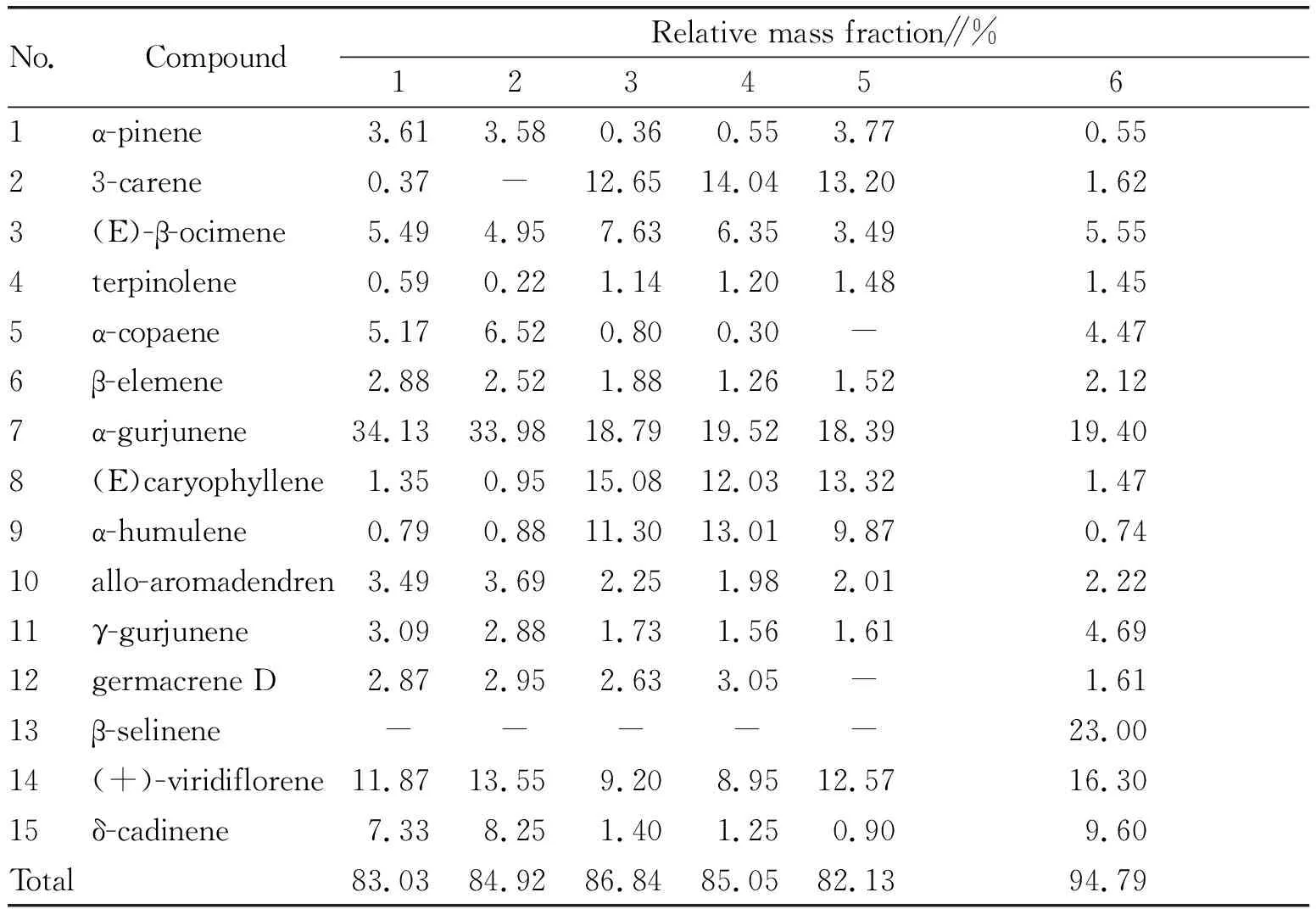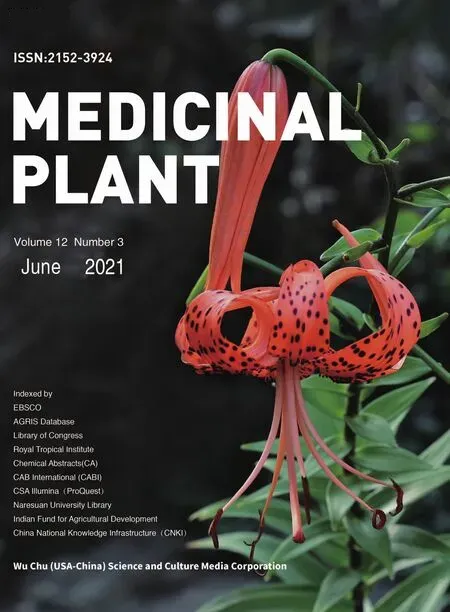GC-MS Analysis of Volatile Oils in Mango Leaves from Different Producing Areas
Xu FENG, Chuanxian QIN, Qingxia HUANG, Chengzhi DU, Chenyan LIANG
Guangxi University of Chinese Medicine, Nanning 530001, China
Abstract [Objectives] To analyze the composition of volatile oils from mango leaves from different producing areas. [Methods] The volatile oils in mango leaves from different areas was extracted by steam distillation, and the GC-MS method combined with retention index and peak area normalization method was used for qualitative and quantitative analysis. [Results] The volatile oils of mango leaves in southern provinces contained high content of terpenes, such as α-gurjunene (18.39%-34.13%), (+)-viridiflorene (8.95%-16.30%) and (E)-β-ocimene (3.49%-7.63%). The volatile oils components of mango leaves were significantly different in different provinces, for example, mango leaves produced in Hainan Province contained a large amount of β-selinene (23.00%), but not in other provinces. [Conclusions] The origin had a great influence on the composition and contents of volatile oils in mango leaves.
Key words Mango leaves, Volatile oils, Gas chromatography-mass spectrometry, Different producing areas
1 Introduction
Mango leaves are the leaves of mango (MangiferaindicaL.), a tropical evergreen tree of the family Anacardiaceae. Mango is also known as Miwangzi, Wangguo, Mameng, Mangguo, Mamengguo, Anboluoguo and so on.It originated in India and Malaysia, and in China, it is mainly distributed in Hainan, Guangdong, Guangxi, Yunnan, Fujian, Sichuan and Taiwan.The record of mango leaves as a traditional Chinese medicine began with theGreatDictionaryofTraditionalChineseMedicinein 1977[1-2].Mango leaves contain ascorbic acid, tannin, mangiferin, isomangolin, homomangolin and ellagic acid, catechin, shikimic acid, quinic acid, kaempferol, thujene and other components[3-4]. Modern pharmacological studies have shown that mango leaves have analgesic, anti-inflammatory, antibacterial, anti-viral, anti-tumor effects[5].At present, the analysis of volatile oils in mango leaves from different producing areas has not been reported. In this experiment, the composition of volatile oils from mango leaves was analyzed by gas chromatography-mass spectrometry (GC-MS), which provided an important basis for the development and utilization of volatile oils from mango leaves.
2 Materials and methods
2.1 MaterialsThe source of mango leaf material is shown in Table 1, and it was identified as the leaf of tropical evergreen tree mango (MangiferaindicaL.) in the family Anacardiaceae by Associate Professor Li Bin from College of Pharmacy, Guangxi University of Chinese Medicine.
2.2 Instruments and reagents7890N-5975C gas chromatog-raphy-mass spectrometer (Agilent); DB-5MS elastic quartz capillary column (30 m × 250 μm × 0.25 μm); G1701DA MSD chemical workstation; volatile oils extractor; centrifuge (LG16-W, Beijing Medical Centrifuge Factory); ultra-pure water system (MILLIPORE); n-hexane (chromatographic purity, Xilong Chemical Co., Ltd.); anhydrous sodium sulfate (analytical purity, Chengdu Kelong Chemical Reagent Factory); C8-C22n-alkanes (chromatographic purity).

Table 1 Mango leaf collection site
2.3 Extraction of volatile oilsAccording to the method for the determination of volatile oils[6]in the 2015 edition ofChinesePharmacopoeia, 200 g of fresh mango leaves from different sources were measured. After shredding, it was placed in a 2 000 mL round bottom flask and soaked with 1 200 mL of water for 2 h. The volatile oils extractor was connected with the reflux condensation tube, and the electric jacket is slowly heated to slightly boil for 6 h. After cooling, it was extracted with n-hexane, dehydrated with anhydrous sodium sulfate and sealed in the refrigerator. All the volatile oils from mango leaves were light yellow with special flavor.
2.4 Gas chromatography-mass spectrometry analysis
2.4.1Gas chromatographic conditions. Injection volume: 1 μL; split injection, split ratio: 20∶1; carrier gas: helium, flow rate: 1.0 mL/min; column temperature: programmed temperature: the initial temperature was kept at 70 ℃ for 3 min, and then increased to 230 ℃ at the rate of 20 ℃/min to keep 2 min.
2.4.2Mass spectrometry conditions. Ionization mode: EI; electron energy: 70 eV; interface temperature: 250 ℃; ion source temperature: 230 ℃; quadrupole temperature: 150 ℃; multiplier voltage: 1 247 V; emission current: 34.6 μA; scanning quality range: 50-550 amu.
3 Results and analysis
3.1 GC-MS experimental resultsThe volatile oils extracted from mango leaves from different producing areas were analyzed by GC-MS according to the above experimental conditions, and the total ion flow diagram of volatile oils from different producing areas was obtained. After the chromatographic n-alkane samples (C8-C22) with the same amount were mixed, the chromatographic analysis was carried out according to the above-mentioned GC-MS conditions, the retention time of each n-alkane was determined and the Kovats retention index of each component was calculated. In accordance with mass spectrometry database (Nist08 and Wiley275) retrieval and manual analysis, the structure of the compound was determined. At the same time, the relative content of each component in the sample was determined by peak area normalization method. The total ion flow chromatogram of volatile oils of sample 1 was shown in Fig.1, and the results of composition analysis of 6 samples were shown in Table 2.

Fig.1 Total ion flow diagram of volatile oils from mango leaf sample 1

Table 2 Volatile oils components of mango leaves from different producing areas
3.2 Common volatile oils in mango leaves from different producing areasAmong the volatile oils from mango leaves from 6 producing areas, the common components with high content were mainly terpenes, accounting for more than 80% of the total content of volatile oils. Among these characteristic components, α-gurjunene had the highest content, accounting for more than 18% of the total volatile oils, as shown in Table 3.

Table 3 Common of volatile oils in mango leaves from different producing areas
4 Conclusions and discussion
In this experiment, 26 components were identified from mango leaf sample 1 (Nanning, Guangxi) (Table 2), and the identified components accounted for 92.83% of the total content of volatile oils. Among them, α-gurjunene accounted for 34.13% of the total content of volatile oils, and other components with higher content included (+)-viridiflorene (11.87%), δ-cadinene (7.33%), (E)-β-ocimene (5.49%), α-copaene (5.17%), accounting for 63.99% of the total content of volatile oils. The result of No.2 sample (Baise, Guangxi) was similar to that of No. 1 sample (Table 2).
25 components were identified from mango leaf sample 3 (Zhanjiang, Guangdong) (Table 2), and the identified components accounted for 96.07% of the total content of volatile oils. The components with higher content included α-gurjunene (18.79%), (E) caryophyllene (15.08%), 3-carene (12.65%), α-humulene (11.30%), (+)-viridiflorene (9.30%), (E)-β-ocimene (7.63%), accounting for 74.75% of the total content of volatile oils. The result of sample 4 (Gaozhou, Guangdong) was similar to that of sample 1 (Table 2).
21 components were identified from mango leaf sample 5 (Hainan) (Table 2), and the identified components accounted for 91.41% of the total content of volatile oils. The components with higher content included α-gurjunene (18.39%), (E) caryophyllene (13.32%), 3-carene (13.20%), (+)-viridiflorene (12.57%), α-humulene (9.87%), (E)-β-ocimene (3.49%), accounting for 61.41% of the total.
15 components were identified from mango leaf sample 6 (Yunnan) (Table 2), and the identified components accounted for 94.67% of the total. The components with higher content included β-selinene (23.00%), α-gurjunene (19.40%), (+)-viridiflorene (16.30%), δ-cadinene (9.60%), (E)-β-ocimene (5.55%), accounting for 73.85% of the total.
The components with higher content in the six samples were α-gurjunene (18.39%-34.13%), (+)-viridiflorene (8.95%-16.30%), (E)-β-ocimene (3.49%-7.63%). However, the composition of volatile oils varied greatly in different provinces, for example, β-selinene was not found in other samples except sample 6 (Yunnan). (E) caryophyllene existed in all samples, but the content varied greatly, and sample 2 (0.95%) had the lowest content while sample 3 (15.08%) had the highest content, respectively.
Mango leaves and kernels have antitussive and expectorant effects as traditional Chinese medicine. Modern pharmacological studies have shown that mango leaves have pharmacological effects such as relieving cough and relieving asthma, regulating glucose and lipid metabolism, antioxidation, antibiosis, anti-inflammation, and easing pain. The literature shows that the volatile oils of α-gurjunene has good sedative effect. Caryophyllene has a certain antiasthmatic effect[8], and the volatile oils with caryophyllene as the main component has significant inhibitory and inactivating effect onEscherichiacoli,Staphylococcusaureusand so on[9]. α-pinene has antitussive and expectorant effects, and antifungal effects[10].
In this experiment, mango leaves from 6 different producing areas were studied, and the results of composition analysis and identification were different, which might be related to climatic conditions, soil conditions, latitude, altitude, sunshine intensity, cultivation conditions, collection season and other factors. Due to the similarities and differences in the composition and content of volatile oils from different producing areas, the stability and controllability of the base source of medicinal materials should attract the attention of the majority of traditional Chinese medicine researchers. This experiment is of great significance for the further study of pharmacological effects and development of the medicinal plant resources, and can also provide an idea for the identification of the varieties and producing areas of this medicinal material.
- Medicinal Plant的其它文章
- Potential Preventive and Therapeutic Effects of Traditional Chinese Medicine Compound Prescription and Traditional Chinese Medicine Products on COVID-19
- Review of Modern Research on Toxicity of Traditional Chinese Medicine Aconm Lateralis Radix Praeparaia
- Advances in Research of Pharmacological Action and Mechanism of Tibetan Medicine Ranasampel
- Research Progress of External Treatment of Acute Gouty Arthritis with Traditional Chinese Medicine
- Study on Pharmacological Effects of Harmine Hydrochloride
- Research Progress in the Application of Network Pharmacology in Traditional Chinese Medicine and Compound Prescriptions

